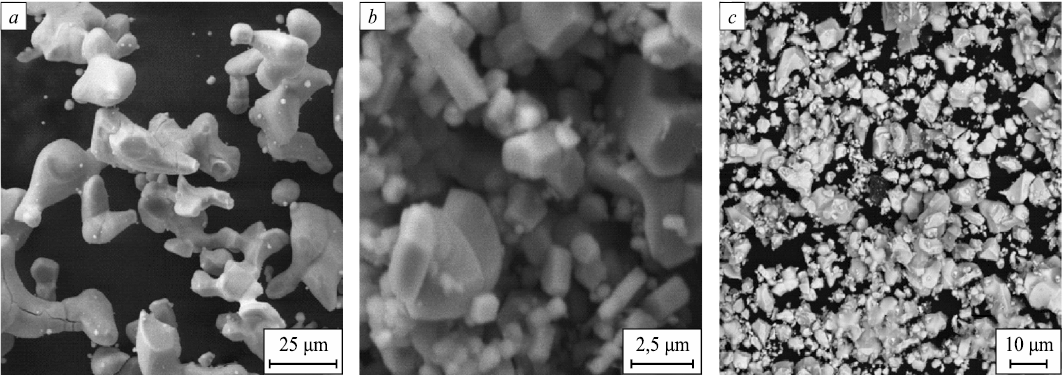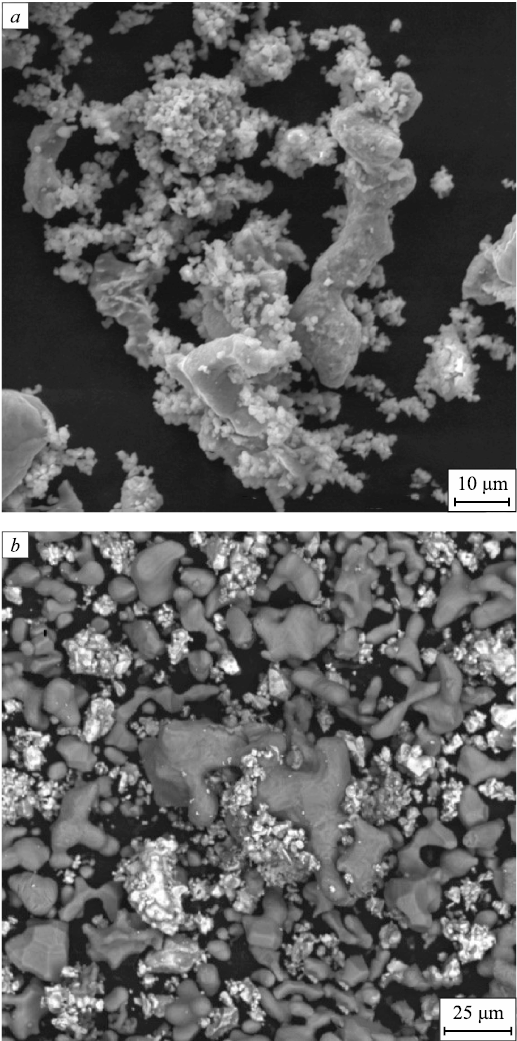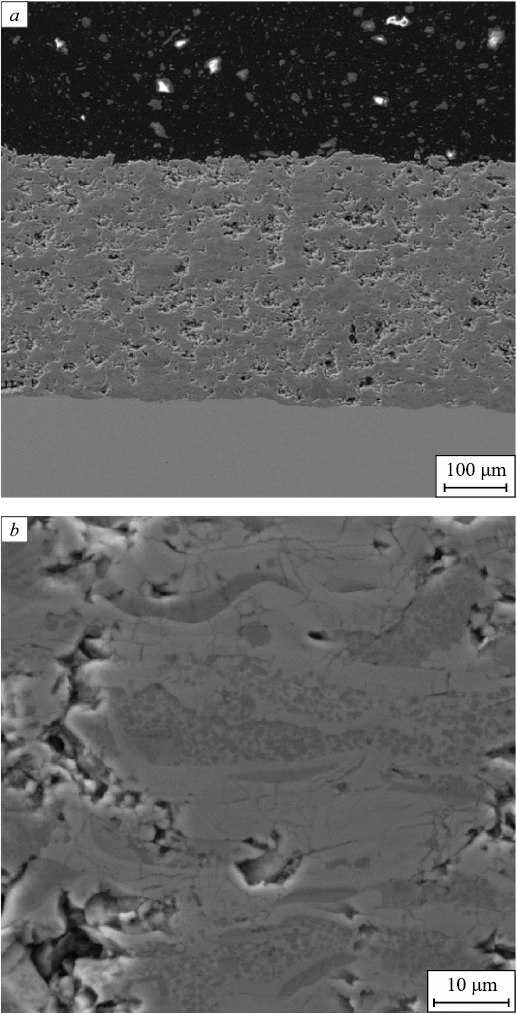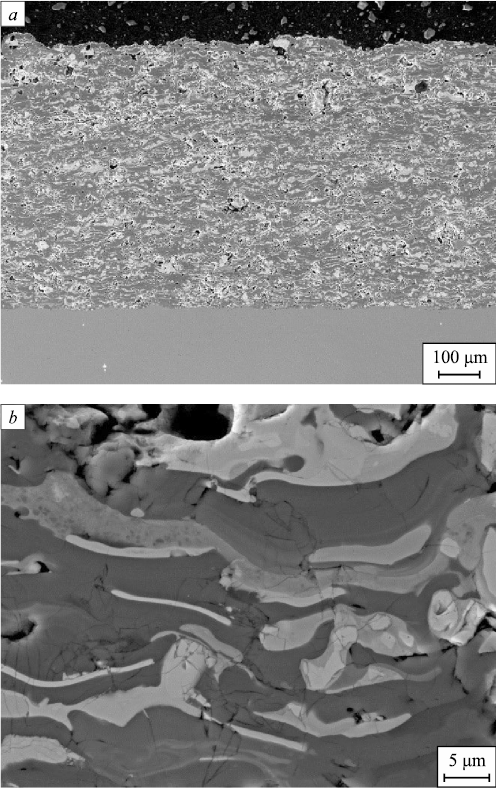Scroll to:
Spraying of TiB\(_{2}\)/Ti and HfB\(_{2}\)/Ti composite powder wear-resistant coatings
https://doi.org/10.17073/0368-0797-2023-1-27-34
Abstract
In this paper we studied the synthesis of composite core-shell powders sprayed as wear-resistant metal-ceramic coatings. High-hardness TiB2 and HfB2 powders form the core, and the shell is made of titanium. The cladding was applied by iodide transport technology. This cladding method involves deposition by gas transport with iodine as an agent. The TiB2 /Ti and HfB2 /Ti composite powders were sprayed using microplasma technology. In contrast to conventional plasma spraying, it minimizes the phase transformations in the composite powders induced by heating. Analysis of the final coating on polished cross sections revealed that during microplasma spraying, the titanium is oxygenated and it produces a titanium dioxide phase. As a result, the TiB2 /Ti and HfB2 / Ti composite powders are transformed into TiB2 (TiB)/Ti(TiO2 ) and HfB2 /Ti(TiO2 ) coatings. We also studied the distribution of the components across the coating. The hardness measurements showed that the titanium diboride coatings obtain microhardness of 1300 HV. The microhardness of the hafnium diboride coatings is about 1600 HV. For abrasion testing of the TiB2 (TiB)/Ti(TiO2 ) and HfB2 /Ti(TiO2 )) coatings we used uncoated alloyed 45Kh steel (similar to EU grade: 41Cr4) and the specified coatings as an abradant material. Despite their lower microhardness, the TiB2 (TiB)/Ti(TiO2 ) coating showed the highest abrasion resistance.
Keywords
For citations:
Goshkoderya M.E., Bobkova T.I., Bogdanov S.P., Krasikov A.V., Staritsyn M.V., Kashirina A.A. Spraying of TiB\(_{2}\)/Ti and HfB\(_{2}\)/Ti composite powder wear-resistant coatings. Izvestiya. Ferrous Metallurgy. 2023;66(1):27-34. https://doi.org/10.17073/0368-0797-2023-1-27-34
Introduction
New structural materials and coatings are developed to offer better performance and reliability. New composites extend the service life of products operating at high rates under elevated temperatures, mechanical loads or exposed to aggressive environments.
Borides of transition metals, such as TiB2 and HfB2 are promising ones since they have a high level of hardness, heat, wear and corrosion resistance [1 – 5]. There are few boride coating application technologies. Jayaraman S. et al. [6] produced HfB2 and Hf – B – N coatings by chemical vapor deposition (CVD). The hardness of the coatings is up to 40 GPa. The CVD technology is also used to apply ultra-high-temperature transition metal boride coatings onto porous substrates. The application technology for such coatings consist of thermal gas-phase decomposition of titanium, zirconium and hafnium borohydride solutions in high-boiling saturated hydrocarbons as borohydride and solvent vapor are passed through porous materials preheated to 250 °C, and then placed in a tubular reactor under vacuum (Dugin S.N. et al. [7]).
Composite HfB2/SiC coatings protect from oxidation in various aggressive environments [8 – 12] and are therefore of a great interest. Silicon carbide alloying with hafnium diboride significantly increases the structural strength at high temperatures, thermal conductivity and heat resistance while reducing the thermal expansion coefficient. Such coatings are extensively used under high temperatures and contact loads, e.g. in solid-propellant rocket engine components [13].
Spark plasma sintering (SPS) is used for sintering ceramic powders. This technology produces ultra-high-temperature and high-strength ceramics [14 – 16]. The standard temperature of HfB2 – SiC spark plasma sintering is 1800 – 2100 °C [17].
Despite their excellent performance and physical/structural properties, such coatings are not widely used due to their high brittleness and the lack of direct application technologies. Therefore, it is advisable to use boride composites with binding metals.
Gas cladding is an efficient technology for making highly dispersed composite powders; one component is converted into a gas phase and then deposited on the surface of the other component. Iodine is used as a transport agent. Bogdanov S.P. [18; 19] studied the iodine transport of cladding components in detail [18, 19].
As components operated under high contact loads are restored a layer up to 1 mm thick [20] is mostly applied.
Thermal spraying is considered a suitable technology for making coatings of such thicknesses [21]. In particular, the microplasma technology can spray composite powders while maintaining their high physical and structural properties. 20 – 300 μm thick coatings are applied with a single pass.
The above-mentioned composite powders can be used as protective and repair coatings for mechanical parts exposed to high contact loads, variable temperatures and aggressive or corrosive environments in heat exchangers, steam generators, pipelines, valves and jet engines.
The purpose of this study is to apply the iodine transport technology to TiB2 /Ti and HfB2 /Ti composite powders, fine-tune the microplasma spraying process, and estimate the properties of the resulting coatings.
Materials and Methods
We used the following materials:
– PTOM-1 titanium powder, 10 – 100 μm grade from POLEMA, AO (see Table 1 for the chemical composition);
– titanium diboride powder, 1 – 4 μm grade (the chemical composition is: 68.3 % titanium; 30.2 % boron; 0.1 % carbon; 0.05 % iron);
– HfB2 hafnium diboride powder, 3 – 12 μm grade, 99.8 % purity (the chemical composition is: boron 29 %; the rest is hafnium).
Fig. 1 shows the SEM images of the powders. The powders were mechanically mixed.
Fig. 1. SEM micrographs of the powders: |
Table 1. Chemical composition of PTOM-1 powder
| ||||||||||||||||||||||
The MeB2 :Ti mass equivalent ratio was 50:50 %, where Me is Ti or Hf. The mixtures were then synthesized by the iodine transport technology. The titanium was converted into a gas phase by a chemical reaction with iodine vapor and carried to the surface of ceramic particles. The mass transfer intensity depends on the temperature and the holding time. The temperature was 700 °C, and the holding time was 3 h. The resulting TiB2 /Ti and HfB2 /Ti composite powders, 20 to 80 μm grade were deposited with the microplasma technology on UGNP-7/2250 machine equipped with Kawasaki FS003N robot manipulator. The plasma generator power reached 2.8 kW and the arc current was 35 to 40 А at 40 V. Argon (2 l/min flow rate) served as the transport agent and plasma gas.
We studied the structure of the powders and the polished cross-sections of the coatings on Tescan Vega 3 scanning electron microscope (SEM). PMT-3 microhardness tester was used for the coating microhardness testing by Vickers method.
The 2168 UMT abrasion testing machine performed accelerated wear resistance tests. It is a general-purpose machine with replaceable friction pairs and multiple available motions in a wide range of rpm and loads. Lubricants can be delivered to the friction area. The samples had coating sprayed on their ends. They were arranged as a ring-on-ring friction pair with continuous water cooling. The independent variables were the normal load applied to the ring, the ring rpm and the test time. All the samples were examined under the 0.5 MPa load at 100 rpm for 5 h.
Results and Discussion
We examined the structure of the TiB2 /Ti and HfB2 / Ti composite powders processed by the iodine transport technology. The typical structure is shown in Fig. 2.
Fig. 2. SEM images of the clad powders: |
The composite particles mostly inherit the shape of the original ceramic components, while some of the particles remain unclad and they are merged in agglomerates.
Fig. 3 and 4 show the SEM images of the TiB2 /Ti and HfB2 /Ti composite powder coating polished cross-sections respectively.
The images in Fig. 3 and 4 indicate that the coatings have clear interfaces with the substrate, without through pores. The dark and bright areas in the backscattered electron SEM images indicate that the titanium diboride and hafnium diboride particles are preserved in the coating. Fig. 3 shows that the light areas are titanium and the dark areas are titanium diboride. In the SEM images of the coatings (Fig. 4) the darker areas are rich in titanium and the lighter areas are rich in hafnium, due to the higher atomic number of the latter. The titanium diboride coating changes its phase composition during spraying. The diboride is partially converted into titanium monoboride. A similar effect was given in [22; 23]. The hafnium diboride powder coating does not feature such transformations. Besides, the titanium dioxide phase is formed in the coatings due to the oxygen diffusion during spraying. It can be identified as the areas with an intermediate contrast between the areas containing the ceramic and the binder.
|
We examined the microhardness of the polished cross-sections of the coatings. The hardness of TiB2 (TiB)/Ti(TiO2 ) coating is 1320 HV under 100 g load and 1.0 rms deviation. The hardness of HfB2 /Ti(TiO2 ) is 1654 HV under 200 g load and 3.2 rms deviation.
The results indicate high hardness values of the ceramic components in the coatings. HfB2 /Ti has higher hardness because the ceramic component does not have a phase transition. As mentioned above, the titanium diboride is saturated with titanium at spraying, which resulted in monoboride formation. It slightly decreases the final hardness, since the hardness of the titanium diboride reaches 35 GPa, while that of the titanium monoboride is 28 GPa [24; 25] only.
We also tested the sprayed coatings for abrasion resistance. First, we used 41Cr4 steel as an abradant material (Table 2, tests 1 and 2). Then we tested the abrasion resistance of two samples with two types of coatings (Table 2, test 3). Table 2 shows the weight changes, weight wear and wear rates for each friction pair.
Table 2. Wear resistance properties of the coatings
| |||||||||||||||||||||||||||||||||||||||||||||||||
The weight wear of TiB2 (TiB)/Ti(TiO2 ) coating is 28 %, which is less than that of the steel part. The mass losses of the sample and the abradant materials were low. The similar test with a friction pair of a hafnium diboride coating sample and 41Cr4 abradant material showed that the sample mass loss increases while the steel body wear is 690 % higher than that of the coated sample. The reason is the higher hardness of HfB2 /Ti(TiO2 ) coatings.
Abrasion tests of TiB2 (TiB)/Ti(TiO2 ) and HfB2 /Ti(TiO2 ) coatings showed that the titanium diboride coating had higher wear resistance.
The weight wear of HfB2 /Ti(TiO2 ) coating is 290 % higher than that of TiB2 (TiB)/Ti(TiO2 ) coating despite its higher microhardness. This can be explained by better elasticity of titanium diboride coatings, since spraying forms titanium monoboride. The substance creates a chemical bond between crystal lattices of initial phases, which prevents the ceramic component removal by friction. The hafnium diboride coating lacks such a bond. As a result, HfB2 /Ti(TiO2 ) coating wear rate is higher than that of TiB2 (TiB)/Ti(TiO2 ) coating under identical contact loads.
Conclusions
We synthesized TiB2 /Ti and HfB2 /Ti metal-ceramic powders. The initial mass ratio of the components in the mixture was 50:50 %. The synthesis lasted for 3 h at 700 °C.
We studied the properties of TiB2 /Ti and HfB2 /Ti composite powder coatings applied with the microplasma technology.
The structural examination showed that the particles of ceramic components are fixed in the matrix without any through pores. During spraying the energy input changes the phase composition of titanium diboride composite powders from TiB2 /Ti to TiB2 (TiB)/Ti(TiO2 ).
Hardness of TiB2 (TiB)/Ti(TiO2 ) coating is 1320 HV and the hardness of HfB2 /Ti(TiO2 ) coating is 1654 HV. The abrasion tests indicated that for the steel grade 45H abradant material, the weight wear of the coatings is 28 % less than the wear of the steel body. TiB2 (TiB)/Ti coating offers the best performance with the lowest wear under a contact load with a steel body.
References
1. Gerasimova N.S. The Main Types of Composite Materials and Ceramics: Manual. Bauman Moscow State Technical University; 2019: 32. (In Russ.).
2. Ivantsov A.E., Rozhkova G.A. Borides: Methodical instruction. Kazan: Kazan State Technol. University; 2006: 19. (In Russ.).
3. Goncharov A.A., Dub S.N., Agulov A.V., Petukhov V.V.
4. Structure, composition, and mechanical properties of thin films of transition metals diborides. Journal of Superhard Materials. 2015; 37(6): 422–428. https://doi.org/10.3103/S1063457615060076
5. Liang R., Shiota T., Omiya Y., Fujii M. Dry friction and wear behavior of various boride hard coating films. The Proceedings of Conference of Chugoku-Shikoku Branch. 2021; 59: 05b1. https://doi.org/10.1299/jsmecs.2021.59.05b1
6. Portnova E.N. Production of ultra-high-temperature ceramic materials based on zirconium and hafnium diborides: Cand. Tech. Sci. Diss. Perm National Research Polytechnic University; 2016: 137. (In Russ.).
7. Jayaraman S., Gerbiac J.E., Yangac Y., Kimbc D.Y., Chatterjeeac A., Bellonac P., Girolamibc G.S., Chevalierd J.P., Abelsonac J.R. HfB2 and Hf–B–N hard coatings by chemical vapor deposition. Surface and Coatings Technology. 2006; 200 (22–23): 6629–6633. https://doi.org/10.1016/j.surfcoat.2005.11.040
8. Dugin S.N., Grebennikov A.V., Bogachev E.A., Gurkova E.L., Storozhenko P.A., Kolomiitsev I.A., Stepanov G.V. Method of applying oxidation-resistant and ultra-high-temperature coatings of titanium, zirconium and hafnium diborides to composite material. Patent RF no. 2 675 618. Publ. 20.12.2018 (In Russ.).
9. Pavese M., Fino P., Badini C., Ortona A., Marino G. HfB2/SiC as a protective coating for 2D Cf/SiC composites: Effect of high temperature oxidation on mechanical properties. Surface and Coatings Technology. 2008; 202 (10): 2059–2067. https://doi.org/10.1016/j.surfcoat.2007.08.037
10. Ren X., Li H., Chu Y., Fu Q., Li K. Ultra-high-temperature ceramic HfB2-SiC coating for oxidation protection of SiC-coated carbon/carbon composites. International Journal of Applied Ceramic Technology. 2015; 12 (3): 560–567. https://doi.org/10.1111/ijac.12241
11. Zhou L., Zhang J., Hu D., Fu Q., Ding W., Hou J., Liu B., Tong M. High temperature oxidation and ablation behaviors of HfB2-SiC/SiC coatings for carbon/carbon composites fabricated by dipping-carbonization assisted pack cementation. Journal of Materials Science & Technology. 2022; 111: 88–98. https://doi.org/10.1016/j.jmst.2021.08.092
12. Zhang P., Fu Q., Cheng C., Sun J., Zhang J., Xu M., Zhu X. Microstructure evolution of in-situ SiC-HfB2-Si ternary coating and its corrosion behaviors at ultra-high temperatures. Journal of the European Ceramic Society. 2021; 41(13): 6223–6237. https://doi.org/10.1016/j.jeurceramsoc.2021.05.058
13. Potanin A.Yu., Pogozhev Yu.S., Rupasov S.I., Shvyndina N.V., Levashov E.A. Obtaining SHS-ceramics HfB2-SiC for high-temperature applications. In: New Materials and Technologies: Powder Metallurgy, Composite Materials, Protective Coatings, Welding: Materials of the 14th Int. Sci. and Tech.Conf. Dedicated to the 60th Anniversary of Powder Metallurgy of Belarus, Minsk, September 9–11, 2020. Minsk: Belorusskaya nauka; 2020: 409–414. (In Russ.).
14. Shvaleva N.A., Ivanov M.E. Improving the design and manufacturing technology of the RTTT glass. Aktual’nye problemy aviatsii i kosmonavtiki. 2017; 1(13): 47–49. (In Russ.).
15. Nisar A., Balani K. Phase and microstructural correlation of spark plasma sintered HfB2-ZrB2 based ultra-high temperature ceramic composites. Coatings. 2017; 7(8): 110. https://doi.org/10.3390/coatings7080110
16. Monteverde F. Ultra-high temperature HfB2–SiC ceramics consolidated by hot-pressing and spark plasma sintering. Journal of Alloys and Compounds. 2007; 428(1–2): 197–205. https://doi.org/10.1016/j.jallcom.2006.01.107
17. Zapata-Solvas E., Jayaseelan D.D., Lin H.T., Brown P., Lee W.E. Mechanical properties of ZrB2-and HfB2-based ultra-high temperature ceramics fabricated by spark plasma sintering. Journal of the European Ceramic Society. 2013; 33(7): 1373–1386. https://doi.org/10.1016/j.jeurceramsoc.2012.12.009
18. Grashchenkov D.V., Sorokin O.Yu., Lebedeva Yu.E., Vaganova M.L. Specific features of sintering of HfB2-based refractory ceramic by hybrid spark plasma sintering. Russian Journal of Applied Chemistry. 2015; 88(3): 379–386. https://doi.org/10.1134/S1070427215030040
19. Bogdanov S.P. Preparation of coatings on powders by the iodide transport method. Glass Physics and Chemistry. 2011; 37(2): 172. https://doi.org/10.1134/S1087659611020040
20. Bogdanov S.P. Iodotransport method of obtaining coatings on powders. Izvestiya Sankt-Peterburgskogo gosudarstvennogo tekhnologicheskogo instituta. Khimiya i khimicheskaya tekhnologiya. Tekhnologiya neorganicheskikh veshchestv. 2012;16 (42): 24–28. (In Russ.).
21. Kornev A.B., Kulik Yu.G., Funtikova E.V. On the strategy for restoring parts by gas–thermal spraying. In: Sudostroenie i remont. Vestnik Volzhskogo gosudarstvennogo universiteta vodnogo transporta. 2004: 166–174. (In Russ.).
22. Kalita V.I., Komlev D.I. Plasma Coatings with Nanocrystalline and Amorphous Structure: Monograph. Moscow: Lider M; 2008: 388. (In Russ.).
23. Goshkoderya M.E., Bobkova T.I. Development of new composite materials of volumetrically reinforced configuration based on the Ti/TiB2 system for spraying wear-resistant coatings effective under negative temperatures. In: Coll. of Abstracts of the VIII All-Russ. Youth Sci. Forum “OpenScience 2021”, Gatchina, November 17–19, 2021: 105–106. (In Russ.).
24. Goshkoderya M.E., Bobkova T.I., Staritsyn M.V. Investigation of Ti/TiB2 system composite coatings sprayed by microplasma method. Journal of Physics: Conference Series. 2022; 2182(1): 012073.
25. Krutskii Yu.L., Cherkasova N.Yu., Gudyma T.S., Netskina O.V., Krutskaya T.M. Diborides of transition metals: Properties, application and production. Review. Part 1. Titanium and vanadium diborides. Izvestiya. Ferrous Metallurgy. 2021; 64(2): 149–164. https://doi.org/10.17073/0368-0797-2021-2-149-164
26. Samsonov G.V., Vinitskii I.M. Refractory Compounds (Handbook). Moscow: Metallurgy; 1976: 500. (In Russ.).
About the Authors
M. E. GoshkoderyaRussian Federation
Mikhail E. Goshkoderya, Cand. Sci. (Eng.), Engineer
49 Shpalernaya Str., St. Petersburg 191015, Russian Federation
T. I. Bobkova
Russian Federation
Tat’yana I. Bobkova, Cand. Sci. (Eng.), Head of the Laboratory
49 Shpalernaya Str., St. Petersburg 191015, Russian Federation
S. P. Bogdanov
Russian Federation
Sergei P. Bogdanov, Cand. Sci. (Eng.), Assist. Prof.
24-26/49 Moskovskii Ave., St. Petersburg 190013, Russian Federation
A. V. Krasikov
Russian Federation
Aleksei V. Krasikov, Cand. Sci. (Chem.), Deputy Head of Research Department
49 Shpalernaya Str., St. Petersburg 191015, Russian Federation
M. V. Staritsyn
Russian Federation
Mikhail V. Staritsyn, Engineer
49 Shpalernaya Str., St. Petersburg 191015, Russian Federation
A. A. Kashirina
Russian Federation
Anastasiya A. Kashirina, Engineer
49 Shpalernaya Str., St. Petersburg 191015, Russian Federation
Review
For citations:
Goshkoderya M.E., Bobkova T.I., Bogdanov S.P., Krasikov A.V., Staritsyn M.V., Kashirina A.A. Spraying of TiB\(_{2}\)/Ti and HfB\(_{2}\)/Ti composite powder wear-resistant coatings. Izvestiya. Ferrous Metallurgy. 2023;66(1):27-34. https://doi.org/10.17073/0368-0797-2023-1-27-34




































